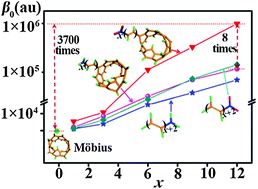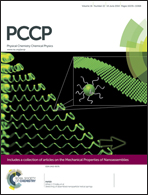Constructing a mixed π-conjugated bridge to effectively enhance the nonlinear optical response in the Möbius cyclacene-based systems
Abstract
Using density functional theory computations, employing the concept of a mixed π-conjugated bridge can effectively improve the first hyperpolarizability (β0) of Möbius cyclacene (MC)-based systems with a D–π–A framework. This mixed π-conjugated bridge is constructed by applying a –(CH![[double bond, length as m-dash]](https://www.rsc.org/images/entities/char_e001.gif) CH)x–NH2 or –(CH
CH)x–NH2 or –(CH![[double bond, length as m-dash]](https://www.rsc.org/images/entities/char_e001.gif) CH)x–NO2 chain to modify [8]MC, which can lead to a considerable β0 value (e.g. [8]MC–(CH
CH)x–NO2 chain to modify [8]MC, which can lead to a considerable β0 value (e.g. [8]MC–(CH![[double bond, length as m-dash]](https://www.rsc.org/images/entities/char_e001.gif) CH)12–NO2 (9.87 × 105 au) with only a certain chain length), much larger than the sole [8]MC (261 au) and the corresponding NH2/NO2-modified polyethylene chain with the same π-conjugated length. It is revealed that the substituent sites and the chain length can play a crucial role in improving β0 values of these MC–chain systems, where the β0 value can monotonically increase with increasing –(CH
CH)12–NO2 (9.87 × 105 au) with only a certain chain length), much larger than the sole [8]MC (261 au) and the corresponding NH2/NO2-modified polyethylene chain with the same π-conjugated length. It is revealed that the substituent sites and the chain length can play a crucial role in improving β0 values of these MC–chain systems, where the β0 value can monotonically increase with increasing –(CH![[double bond, length as m-dash]](https://www.rsc.org/images/entities/char_e001.gif) CH)x– length, and the substituent electron-withdrawing –(CH
CH)x– length, and the substituent electron-withdrawing –(CH![[double bond, length as m-dash]](https://www.rsc.org/images/entities/char_e001.gif) CH)x–NO2 chain is superior to the parallel electron-donating –(CH
CH)x–NO2 chain is superior to the parallel electron-donating –(CH![[double bond, length as m-dash]](https://www.rsc.org/images/entities/char_e001.gif) CH)x–NH2. These appealing findings can provide valuable insights into the design of novel NLO materials based on MC.
CH)x–NH2. These appealing findings can provide valuable insights into the design of novel NLO materials based on MC.


 Please wait while we load your content...
Please wait while we load your content...